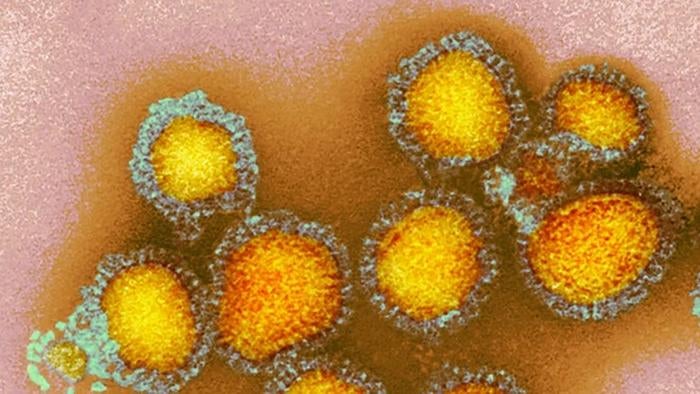- News
- Health
An early analysis suggests current vaccines may still be somewhat effective against the new version of the flu
Mike Stobbe,Nicky ForsterSaturday 22 November 2025 14:58 GMT open image in galleryElectron microscope image of the flu virus (CDC)
open image in galleryElectron microscope image of the flu virus (CDC)
Sign up for our free Health Check email to receive exclusive analysis on the week in health
Get our free Health Check email
Get our free Health Check email
 Email*SIGN UP
Email*SIGN UPI would like to be emailed about offers, events and updates from The Independent. Read our Privacy notice
The US flu season has begun slowly, but health experts are concerned following the emergence of a new viral strain, according to U.S. Centers for Disease Control and Prevention (CDC) data released on Friday.
An early analysis suggests current vaccines may still be somewhat effective against this new version, which is driving recent infections. However, many scientists and medical professionals are more worried about disappointing vaccination rates.
These low rates were a main reason for the unusually high flu hospitalisations and deaths last winter, making it one of the deadliest seasons this century.
“I think we’re going to see a really severe season," said Asefeh Faraz Covelli of the George Washington University School of Nursing.
Last winter, the overall flu hospitalization rate was the highest seen since the H1N1 flu pandemic 15 years ago. Flu was the underlying or a contributing cause of more than 18,000 deaths, and one seven-day stretch early this year saw more than 1,800 deaths — the highest one-week spike in at least a decade. Child flu deaths also were far higher than usual.
CDC data posted Friday showed low flu activity so far, with only one state — Louisiana — reporting moderate activity. Most of the reported infections have been in children, said the CDC's Alicia Budd, who tracks flu infections for the Atlanta-based agency.
Most also have been a new version of the type A H3N2 virus that historically has caused the most hospitalizations and deaths in older people. That type is responsible for most flu infections so far this year, and more than half have been a new subclade K variant that is different from the strain this year's flu shots were built to fight.
 open image in galleryA woman arrives at a CVS pharmacy past a sign about free flu and Covid-19 vaccines on January 14, 2022 in Monterey Park, California. (AFP/Getty)
open image in galleryA woman arrives at a CVS pharmacy past a sign about free flu and Covid-19 vaccines on January 14, 2022 in Monterey Park, California. (AFP/Getty)A preliminary analysis from the United Kingdom suggests the shots do provide at least partial protection, although it will take some time for scientists to know exactly how effective they are. Experts say any protection that softens the blow of a flu infection is important to get.
Flu seasons tend to get bad between December and February, and illnesses likely will accelerate as people travel and gather for Thanksgiving, Covelli said.
“I think it’s going to start picking up here,” she said. “This is the ideal time to get vaccinated.”
Researchers this year have been facing an unusual struggle to get a handle on how respiratory infection and vaccination rates have been trending.
They usually rely on the CDC for data, but a recent government shutdown halted data collection and reporting just as respiratory infections started ramping up.
Meanwhile, government efforts to promote disease-preventing shots have been more limited since U.S. Health Secretary Robert F. Kennedy Jr. was put in charge of the CDC and other federal health agencies. Kennedy, a leading anti-vaccine activist, has fostered uncertainty about the safety of vaccines, including flu shots that contained a preservative called thimerosal.
 open image in galleryUS Health Secretary Robert F. Kennedy Jr. (AP)
open image in galleryUS Health Secretary Robert F. Kennedy Jr. (AP)Indeed, vaccination rates against COVID-19 clearly continue to plummet, with about 6% of children and 14% of adults up to date on their shots, according to other CDC data posted Friday. Each figure is about 3 percentage points less than it was at this point last fall.
For the flu, vaccination trends are a little muddier. Some sources have suggested flu vaccinations are down. Over two million fewer flu shots were given at U.S. pharmacies through the end of October compared to last year, according to data from IQVIA, a health information and research company.
But the latest CDC data indicates that for children, the vaccination rate this year is about the same as it was at this point last fall, at 34%. And the vaccination rate for adults is up a few percentage points to about 37%, according to the CDC data, which relies on survey information.
It is early in the season and too early to know if the increase will be sustained or what is causing it, CDC officials said.
As of the beginning of November, the U.S. flu hospitalization rate is about the same as it was at the same point in 2024. Hospitalization rates for COVID-19 and another respiratory virus, RSV, are lower so far this season, according to another set of CDC data.




